Learning about The Rise of Nationalism in Europe can be a daunting task for students. To help you prepare for your CBSE Class 10 History exam, we've compiled a list of important questions from Chapter 1 The Rise of Nationalism in Europe. With these CBSE questions and answers, you'll have all the information needed to ace your exam!
These questions are compiled by CBSE Guidance from various sources like CBSE PYQs, CBSE official sample papers, NCERT, and other sources. Due care has been taken to cover the entire chapter with these questions. These Q&As can be downloaded in PDF format.
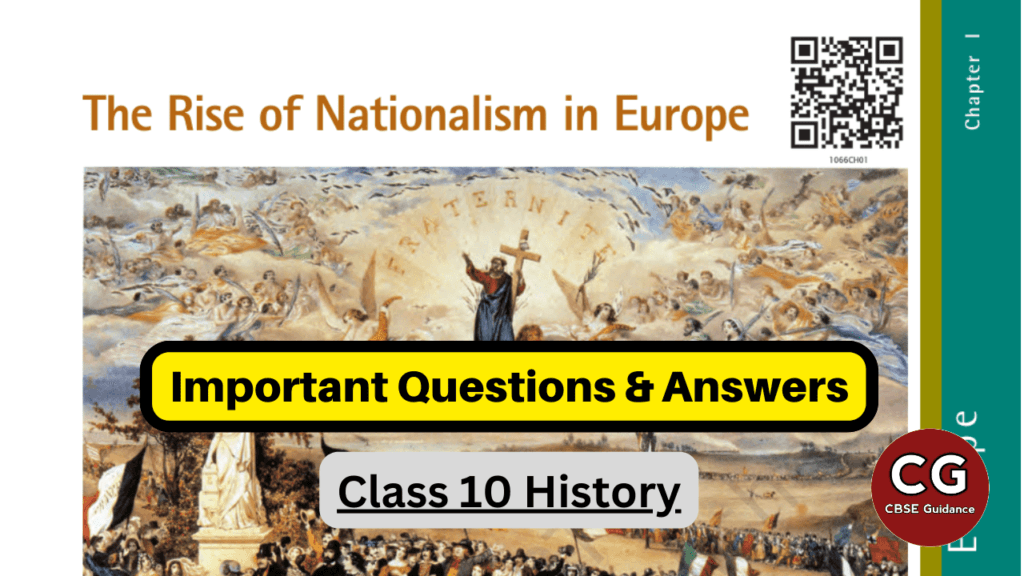
| Subject | Social Science (History) |
| Class | 10 |
| Board | CBSE |
| Chapter No. | 1 |
| Chapter Name | The Rise of Nationalism in Europe |
| Type | Important Questions & Answers |
| Session | 2024-25 |
| Weightage | 6 marks |
"Don't watch the clock; do what it does. Keep going."
- Sam Levenson
Q. No. 1) Multiple Choice Questions (MCQs)
i. In the below picture of Frederic Sorrieu’s utopian vision, the saints, angle, and Christ symbolize:
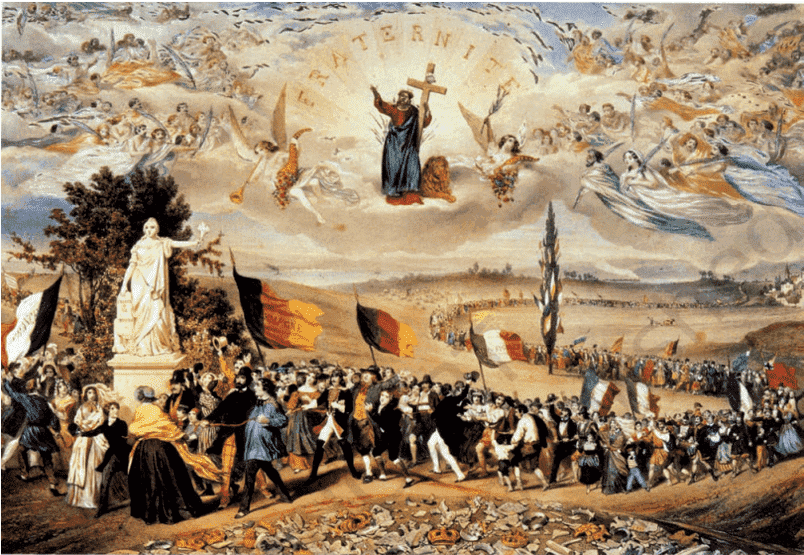
a. Equality among people
b. Fraternity among nations
c. Freedom of nations
d. Resentment against nations
Ans. Option (b).
ii. Indicate which of the following option is NOT correct:
Napoleon’s invasions were resented in several countries due to _____.
a. Increased taxation
b. Censorship
c. Forced conscription into the French armies
d. Abolishment of the feudal system
Ans. Option (d).
iii. Which was not a quality of Napoleon’s civil code (1804) from the following?
a. Right by birth
b. Right to property
c. Right to vote for all
d. Equality before law
Ans. Option (a).
iv. Identify the ideology under which people demanded freedom of markets in early-19th century Europe.
a. Romanticism
b. Liberalism
c. Socialism
d. Rationalism
Ans. Option (b).
v. Identify the correct statement with regard to the ‘Zollverein’ from the following options:
a. It was a coalition of Prussian states formed to manage political alliances.
b. Its aim was to bind Prussia politically into an association.
c. It was a Custom Union at the initiative of Prussia.
d. It helped to awaken and raise national sentiment in Europe.
Ans. Option (c).
vi. Why was a customs union or Zollverein formed by Prussia and most of the German states in 1834?
a. To abolish state-imposed restrictions on the movement of goods and capital
b. To encourage the state-wise system of weights and measures
c. To import more goods from the landlocked Balkans
d. To boost trade with England and France
Ans. Option (a).
vii. Most conservative regimes set up in 1815 imposed censorship laws. Which of the following did they want to control through such laws?
- P – what was written about them
- Q – the increasing demand for modernizing the army
- R – the spread of ideas of liberty and freedom reflected in the newspapers
- S – the spread of the idea that modernization could strengthen traditional institutions
Options
a. Only P and Q
b. Only P and R
c. Only Q and S
d. Only R and S
Ans. Option (b).
viii. Who among the following was the founder of the ‘Young Europe’ underground secret society in Berne?
a. Giuseppe Garibaldi
b. Giuseppe Mazzini
c. Count Cavour
d. Otto Von Bismarck
Ans. Option (b).
ix. “When France sneezes,” Metternich once remarked, “the rest of Europe catches cold.”
What did Duke Metternich mean by this statement?
a. France’s Bourbon dynasty was the most influential line of kings in Europe.
b. French trade guilds wielded enormous powers over European trade.
c. France had begun annexing neighboring nations after 1815.
d. France’s nationalist movement inspired other nations.
Ans. Option (d).
x. Which of the following treaty recognized Greece as an independent nation?
a. Treaty of Sevres
b. Treaty of Versailles
c. Treaty of Lausanne
d. Treaty of Constantinople
Ans. Option (d).
xi. Who was proclaimed the King of United Italy, in 1861?
a. Giuseppe Garibaldi
b. Victor Emmanuel II
c. Giuseppe Mazzini
d. Macedonia
Ans. Option (b).
xii. Why did the weavers in Silesia revolt against contractors in 1845? Identify the appropriate reason from the following options.
a. Contractors did not pay their dues
b. Contractors appointed few on high posts
c. Contractors used government policies
d. Contractors gave them loans on high interests
Ans. Option (a).
xiii. Which of the following countries were involved in the Three Wars with Prussia and ended with victory and unification of Germany?
a. Austria, Poland, and France
b. Austria, Denmark, and France
c. Austria, Turkey, and France
d. Austria, England, and France
Ans. Option (b).
xiv. Which of the following was NOT an ethnic group that inhabited the British Isles in the 16th century?
a. The English
b. The British
c. The Scots
d. The Irish
Ans. Option (b).
xv. Identify the major aspect that helped in the formation of a nation-state in Britain.
a. In 1688, the monarch of Britain fought a war with English Parliament.
b. The Parliament through a bloodless revolution seized power from the monarchy.
c. The British nation was formed as a result of a war with Ireland and Wales.
d. The formation of a nation-state in Britain was the result of many revolts.
Ans. Option (b).
xvi. Which of the following was the result of the Act of Union, 1707?
a. Unification of Germany
b. Unification of the Kingdom of Great Britain
c. Unification of Italy
d. Unification of Vietnam
Ans. Option (b).
xvii. Identify the name of the Prussian King who was proclaimed German Emperor in a ceremony held at Versailles.
a. William I
b. William II
c. Henry VII
d. Louis IV
Ans. Option (a).
xviii. Following image is the personification of Germany commonly associated with the Romantic Era and the Revolutions of 1848. Which of the following aspect best signifies this image of ‘Germania’?
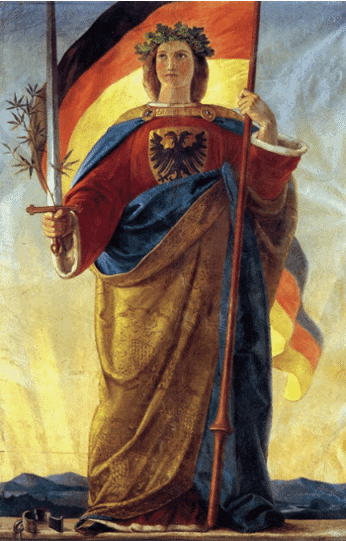
a. Heroism and Justice
b. Folk and Cultural Tradition
c. Austerity and Asceticism
d. Revenge and Vengeance
Ans. Option (a).
xix. Choose the correct statement about the image given below:
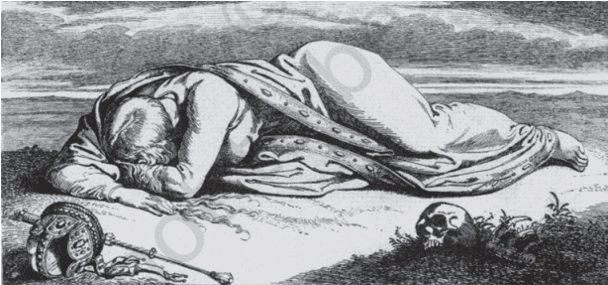
a. This image was painted by artist Lorenz Clasen.
b. This image was painted by artist Julius Hubner.
c. Germania guarding the Rhine was the title of this painting.
d. Philip Veit, was the artist who made this painting.
Ans. Option (b).
xx. Choose the correctly matched pair from the following:
a. Otto Von Bismarck - Germany
b. Napoleon - Spain
c. Giuseppe Garibaldi - France
d. Bourbon Kings - Italy
Ans. Option (a).
xxi. Choose the correct option from column A and column B.
| Column A | Column B |
| a. Absolutist | i. A vision of society |
| b. Utopian | ii. A form of government |
| c. Plebiscite | iii. A system of direct vote |
| d. Suffrage | iv. A system of holding an election |
Ans. Option (c).
xxii. Which of the following option(s) is/are correct about Balkan nationalism?
I. The Balkan region became part of the conflict because of the Ottoman Empire.
II. The region comprised ethnic groups including Greeks, Serbs, Montenegro, etc.
III. British and ethnic nationalists struggled to establish their identity.
Options
a. I & II
b. II & III
c. Only II
d. Only I
Ans. Option (a).
xxiii. Which of the following is an allegory for liberty?
a. Crown of Oak
b. Red cap
c. Olive branch
d. Sword
Ans. Option (b).
xxiv. Given below are some allegories used in Europe during the nationalist movement. Accordingly, which one of the following signified the beginning of a new era?
a. Broken chains
b. Rays of the rising sun
c. Breastplate with eagle
d. Olive branch around a sword
Ans. Option (b)
xxv. Identify the painting from the options given below.
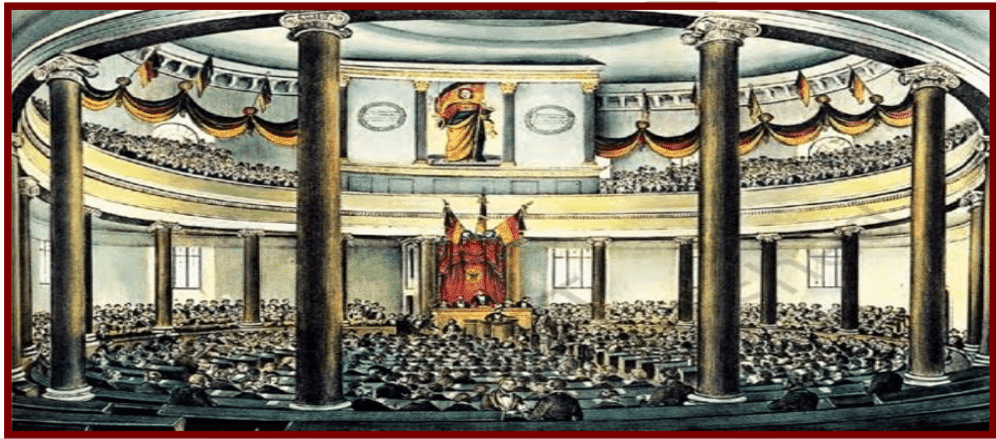
a. Frankfurt Parliament
b. Reichstag
c. Duma
d. The House of Parliament
Ans. Option (a)
Q. No. 2) Match the following symbols from column A with their meanings from column B.
| Column A (Symbols) | Column B (Meanings) |
| a. Broken chains | i. Heroism |
| b. Sword | ii. Being freed |
| c. Crown of oak leaves | iii. Symbol of the German empire - strength |
| d. Breastplate with eagle | iv. Readiness to fight |
Ans. a-ii, b-iv, c-i, d-iii.
Q. No. 3) Explain the measures and practices introduced by the French revolutionaries to create a sense of collective identity amongst the French people.
Ans.
- The ideas of La Patrie (the fatherland) and Le Citoyen (the citizen) emphasized the notion of a united community enjoying equal rights under a constitution.
- A new French flag, the tricolor, was chosen to replace the former Royal Standard.
- The Estates General was elected by the body of active citizens and renamed the National Assembly.
- New hymns were composed, oaths taken and martyrs commemorated all in the name of the nation.
- A centralized administrative system was introduced and it formulated uniform laws for all citizens.
- Internal customs duties and dues were abolished and a uniform system of weights and measures was adopted.
- Regional dialects were discouraged and French became the common language of the nation.
Q. No. 4) Evaluate the impact of Napoleonic reforms on the rest of Europe.
Or,
How would you evaluate Napoleon as an administrator who created a more rational and efficient system? Elucidate with suitable examples.
Ans. The impact of Napoleonic reforms on the rest of Europe was:
- Through a return to monarchy, Napoleon destroyed democracy in France.
- The administrative field was made rational and efficient.
- The Civil Code of 1804 (Napoleonic Code) did away with all the privileges based on birth, established equality before the law, and secured the right to property.
- In the Dutch Republic, Switzerland, Italy, and Germany, Napoleon simplified the administrative divisions, abolished the feudal system, and freed the peasants from serfdom and manorial dues.
- In the towns, guild restrictions were removed.
- Transport and communication systems were improved.
However, increased taxation, censorship, forced conscription into the French armies required to conquer the rest of Europe, all seemed to outweigh the advantages of the administrative changes.
Q. No. 5) Describe the ideology of liberalism during the early 19th century.
Or,
Ideas of national unity in early 19th-century Europe were closely allied to the ideology of liberalism. What did it mean for the middle class in France? Explain.
Ans.
- Liberalism in the early 19th century stood for freedom for the individual and equality for all before the law for the new middle classes.
- Politically, it emphasized the concept of government by consent.
- It stood for the end of autocracy and clerical privileges, and the rise of a constitution, and a representative government through parliament.
Q. No. 6) What was the main aim of the Treaty of Vienna 1815? What were the main provisions of the Treaty of Vienna held in 1815?
Ans. The main aim was to undo most of the changes that had come about in Europe during the Napoleonic wars.
The main provisions of the Treaty of Vienna held in 1815 were:
- The Bourbon dynasty which was destroyed during the French Revolution was restored to power.
- France lost the territories it had annexed under Napoleon.
- A series of states were set up on the boundaries of France to prevent French expansion in the future.
- Prussia was given new territories on its western frontiers, and Austria was given control of northern Italy.
- The German confederation of 39 states set up by Napoleon was left untouched.
- Russia was given part of Poland and Prussia was given part of Saxony.
- The monarchy was restored and a new conservative order was created in Europe.
Q. No. 7) How had Revolutionaries spread their ideas in many European states after 1815? Explain with examples.
Ans. After the Congress of Vienna in 1815 when conservative regimes were restored to power, the fear of repression drove many liberal nationalists underground. Secret societies sprang up in many European states to train revolutionaries and spread their ideas.
- Giuseppe Mazzini, an Italian Revolutionary founded two underground societies: Young Italy in Marseilles and Young Europe in Berne. The members believed in the formation of nation-states and they were liberal-minded people. Following his model, secret societies were set up in Germany, France, Switzerland, and Poland.
- The Romantics used folk songs, folk poetry, and folk dances to popularize the true spirit of the nation. For example, Karol Kurpinski celebrated the national struggle through his operas and music in Poland. He turned folk dances like polonaise and mazurka into nationalist symbols.
- Language also played an important role in developing nationalist sentiments. For example, it was mainly used as a weapon of national resistance when the Polish language was forced out of schools and the Russian language was imposed everywhere in Europe.
Q. No. 8) Describe the role of Giuseppe Mazzini as an Italian Revolutionary.
Ans. Role of Giuseppe Mazzini as an Italian Revolutionary:
- Italian revolutionary Giuseppe Mazzini was born in Genoa in 1807. He became a member of the secret society of the Carbonari.
- He founded two underground societies, first Young Italy in Marseilles and Young Europe in Berne. Members of these societies were like-minded young men from Poland, France, Italy, and German states.
- Mazzini strongly believed that God had intended nations to be the natural units of mankind. So Italy had to be forged into a single unified republic within a wider alliance of nations.
- Following his model, secret societies were set up in Germany, France, Switzerland, and Poland.
- Mazzini’s relentless opposition to monarchy and his vision of democratic republics frightened the conservatives.
Q. No. 9) Write a short note on the Greek War of Independence.
Ans. Greek War of Independence:
- An event that mobilized nationalist feelings among the educated elite across Europe was the Greek War of Independence.
- Greece had been part of the Ottoman Empire since the 15th century.
- Nationalists in Greece got support from other Greeks living in exile and also from many West Europeans who had sympathies for ancient Greek culture.
- Poets and artists lauded Greece as the cradle of European civilization.
- The English poet Lord Byron organized funds and later went to fight in the war.
- Finally, the Treaty of Constantinople of 1832 recognized Greece as an independent nation.
Q. No. 10) Define the term Romanticism. How did it facilitate the promotion of nationalist sentiment?
Or,
‘Importance of culture – art, poetry, stories, and music help shape nationalist feelings.’ Justify the statement with respect to European nationalism.
Ans. Romanticism: It was a cultural movement that sought to develop a particular form of nationalist sentiment in the following ways:
- Romantic artists and poets generally criticized the glorification of reason and science and focused on emotions, intuition, and mystical feelings.
- The German philosopher Johann Gottfried Herder claimed that through folk songs, folk poetry, and folk dances, the true spirit of the nation could be popularized.
- They gave emphasis on vernacular language and the collection of local folklore to recover an ancient national spirit and to carry the modern nationalist message to large audiences who were mostly illiterate.
Q. No. 11) Explain the ways in which nationalist feelings were kept alive in Poland in the 18th and 19th centuries.
Or,
Explain the role of language in developing national sentiments in Europe.
Or,
‘Language is power, life and the instrument of culture, the instrument of liberation.’ justify the statement in light of the Nationalist sentiments in Poland, and Europe.
Ans. Poland had been partitioned at the end of the 18th century by the Great Powers – Russia, Prussia, and Austria. Even though it did not exist as an independent territory, nationalist feelings were kept alive through music and language.
- Karol Kurpinski, for example, celebrated the national struggle through his operas and music, turning folk dances like the polonaise and mazurka into nationalist symbols.
- When Russia occupied Poland, the Polish language was forced out of schools and Russian was imposed everywhere.
- Many members of the clergy in Poland began to use language as a weapon of national resistance. Polish was used for Church gatherings and all religious instruction.
- As a result, a large number of priests and bishops were put in jail or sent to Siberia by the Russian authorities as punishment for refusing to preach in Russian.
- The use of Polish came to be seen as a symbol of the struggle against Russian dominance.
Q. No. 12) “The 1830s were years of great economic hardship in Europe.” Examine the statement by giving suitable examples.
Ans. The 1830s were years of great economic hardship in Europe in the following ways:
- The first half of the 19th century saw an enormous increase in population which led to widespread unemployment.
- Population from rural areas migrated to the cities to live in overcrowded slums.
- Small producers in towns faced stiff competition from imports of cheap machine-made goods from England.
- In those regions of Europe where the aristocracy still enjoyed power, peasants struggled under the burden of feudal dues and obligations.
- The rise of food prices or a year of bad harvest led to widespread pauperism (poverty) in towns and countries.
Q. No. 13) Name the event that mobilized nationalist feelings among the educated elite across Europe in 1830-1848.
Ans. The event that mobilized nationalist feelings among the educated elite across Europe in 1830-1848 was the Greek War of Independence.
Q. No. 14) The period of 1848 is considered the phase of the Revolution of the Liberals in Europe. Explain.
Ans.
- Events of February 1848 in France had brought about the abdication of the monarch and a republic based on universal male suffrage had been proclaimed.
- In Germany, Italy, Poland, and the Austro-Hungarian Empire – men and women of the liberal middle classes combined their demands for constitutionalism with national unification.
- They took advantage of the growing popular unrest to push their demands for the creation of a nation-state on parliamentary principles – a constitution, freedom of the press, and freedom of association.
- In the German regions, a large number of political associations whose members were middle-class professionals, businessmen, and prosperous artisans came together in the city of Frankfurt and decided to vote for an all-German National Assembly.
- The middle classes resisted the demands of workers and artisans and consequently lost their support. In the end, troops were called in and the assembly was forced to disband.
- The issue of extending political rights to women was a controversial one within the liberal movement, in which large numbers of women had participated actively over the years.
- Women had formed their own political associations, founded newspapers, and taken part in political meetings and demonstrations.
Q. No. 15) Write a short note on “The role of women in nationalist struggles”.
Ans. The issue of extending political rights to women was a controversial one within the liberal movement, in which large numbers of women had participated actively over the years. Women had formed their own political associations, founded newspapers, and taken part in political meetings and demonstrations. Despite this, they were denied voting rights during the election of the Assemble. When the Frankfurt parliament convened in the Church of St. Paul, women were admitted only as observers to stand in the visitors’ gallery.
Q. No. 16) Highlight the role of Otto Von Bismarck in the making of Germany.
Ans. The Role of Otto Von Bismarck in the Making of Germany:
- Prussia took on the leadership of the movement for national unification.
- Its chief minister, Otto Von Bismarck, was the architect of this process carried out with the help of the Prussian army and bureaucracy.
- Three wars over seven years – with Austria, Denmark, and France – ended in Prussian victory and completed the process of unification.
- In January 1871, the Prussian king, William I, was proclaimed German Emperor in a ceremony held at Versailles.
- On January 1871, an assembly comprising the princes of the German states, representatives of the army, and important Prussian ministers including the chief minister Otto von Bismarck gathered in the Hall of Mirrors in the Palace of Versailles to proclaim the new German Empire headed by Kaiser William I of Prussia.
Q. No. 17) “Like Germany, Italy too had a long history of political fragmentation.” Explain.
Ans.
- Italians were scattered over several dynastic states.
- Sardinia-Piedmont was ruled by an Italian princely house.
- Italy was unified in 1861 and Victor Emmanuel II was proclaimed King of United Italy.
- Giuseppe Mazzini had sought to put together a program for a unitary Italian Republic.
- The unification of Italy was a result of many wars. Through a tactful diplomatic alliance with France by Chief Minister Cavour.
- Garibaldi joined the fray.
Q. No. 18) Describe the process of unification of Italy.
Ans. The process of unification of Italy:
- In the 1830s, Giuseppe Mazzini made efforts to unite Italy. He had also formed a secret society called Young Italy.
- The failure of revolutionary uprisings both in 1831 and 1848 meant that the mantle now fell on Sardinia-Piedmont under its ruler King Victor Emmanuel II to unify the Italian states through war.
- Chief Minister Cavour, through a tactful diplomatic alliance with France, succeeded in defeating the Austrian forces in 1859.
- Also, a large number of armed volunteers under Giuseppe Garibaldi joined them.
- In 1860, they marched into South Italy and the Kingdom of the Two Sicilies and succeeded in winning the support of the local peasants in order to drive out the Spanish rulers.
- In 1861 Victor Emmanuel II was proclaimed king of united Italy.
Q. No. 19) ‘In Britain, the formation of the nation-state was not the result of a sudden upheaval on Revolution.’ Elaborate on this statement.
Ans.
- In Britain, the formation of a nation-state was a result of a long drawn-out process.
- There was no British nation prior to the 18th century.
- The primary identities of the people who inhabited the British Isles were ethnic ones such as English, Welsh, Scot, or Irish.
- Later the English Parliament, which had seized power from the monarchy in 1688 at the end of a protracted conflict, was the instrument through which a nation-state with England at its center came to be forged.
- The Act of Union (1707) between England and Scotland that resulted in the formation of the ‘United Kingdom of Great Britain’ meant, in effect, that England was able to impose its influence on Scotland.
Q. No. 20) “While it is easy enough to represent a ruler through a portrait or a statue, how does one go about giving a face to a nation?” Examine this statement in the context of European nationalism in five points.
Ans. Visualizing the Nation:
- Artists in the 18th and 19th centuries personified the nation. They represented a country as if it were a person.
- Artists portrayed nations as female figures.
- Artists used the female allegory to portray ideas such as liberty, justice, and the republic.
- In France, the female allegory was christened Marianne, a popular Christian name, which underlined the idea of a people’s nation.
- Her characteristics were drawn from those of Liberty and the Republic – the red cap, the tricolor, the cockade.
- Statues of Marianne were erected in public squares to remind the public of the national symbol of unity and to persuade them to identify with it.
- Marianne's images were marked on coins and stamps.
- Germania became the allegory of the German nation. She wears a crown of oak leaves, as the German oak stands for heroism.
Q. No. 21) Highlight the reasons for the growth of nationalist tensions in the Balkan region before the First World War.
Or,
Briefly trace the geographical and ethnic variations of the Balkans region. Why did this region become politically very explosive?
Ans.
- The Balkan was a region of geographical and ethnic variations comprising modern-day Romania, Bulgaria, Albania, Greece, Macedonia, Croatia, Bosnia-Herzegovina Slovenia, Serbia, and Montenegro. The inhabitants were called Slavs.
- A large part of the Balkans was under the control of the Ottoman Empire while some other parts were under the control of Russia and Austria causing a complex problem.
- The spread of ideas of Romantic nationalism in the Balkans together with the disintegration of the Ottoman Empire made the region very explosive.
- Different Slavic nationalists struggled to define their identities.
- The Balkan region became a region of intense conflict over the expansion of territory.
- At the same time, the great European Powers – Russia, Germany, England, and Austro-Hungary were keen on taking the control of the Balkan region, since it was important from the trade point of view.
- This led to a series of wars in the region and finally became the cause of the First World War.
Q. No. 22) Why did Slavic nationalists struggle in the 19th century? Give reason.
Ans. To define their identity and independence.
Q. No. 23) “The idealistic liberal-democratic sentiment of nationalism in the first half of the 19th century became a narrow creed with limited ends.” Examine the statement.
Ans.
- During this period, nationalist groups became increasingly intolerant of each other and were ever-ready to go to war.
- Major European powers manipulated the nationalist aspirations to further their own imperialist aims.
- The most serious source of nationalist tension in Europe after 1871 was the area called the Balkans.
- The idea of romantic nationalism in the Balkans together with the disintegration of the Ottoman Empire made this region very explosive.
- One by one, European nationalities broke away from their control and declared independence.
- The Balkan people based their claims for independence or political rights on nationality and used history to prove that they had once been independent but had subsequently been subjugated by a foreign power.
- As the different Slavic nationalities struggled to define their identity and independence, the Balkan area became an area of intense conflict.
| You Might Also Like: CBSE Class 10 Notes CBSE Class 10 Important Questions and Answers |
Hope these questions helped you in preparing this chapter. Please share this with your friends and do comment on your doubts/questions/suggestions in the comment section below.

How to download pdf
Go to download 😁💪
Sir, I’m Shanmukh my science exam performance is bad. I did not give complete to your questions that’s why I performed badly in the exam. But from now I will give complete attention to all your questions and answers. Sir, should I by hard the questions or understand each question carefully because there are a lot of questions.
Don’t worry about the past. It is not possible to learn by heart all these questions in this short time. I would recommend you to just memorize the key points in each answer and then frame your own answer.
Thanks sir 🙏
Stress management techniques very much important for you
You should be need to follow them
1. Masterbating
2.fingring
3porn
Sir I think MCQ no (iii) has wrong answer as right to vote for all is also not a quality of Napoleonic code
You are right mai bhi vhi soch rhi thi…..
Sir, I am kavya and don’t S.st. then how can I do my s.st exam in board exam
Sir, I am kavya and I don’t understand S.st. but I want to do best in her board exam so how can I perform nicely in s.s.t in her board exam. Sir please guide me
For SST simply follow the NCERT and the important questions provided by me on this website. First Watch and understand the chapter from my youtube channel, then prepare the important questions.
These questions are helping me for the preparation of pre boards…😁
A useful website for board preparation.
Sir , Are this questions are enough to score good marks in sst exam??
Will this question come as it is in the examination??.
sir practicing these questions are enough for board please answer
Yes
Hmmm,sir krlo apni tarif🫵🏻😂
Ahh ahhh apne mu Miya muthu🤭
Likin sahi baat hai apse padhe ke baad top to hone paka hai.
Isiliye isko test krne ke liye kal mera exam hai😂🤣🤣